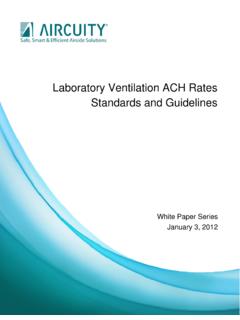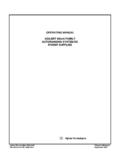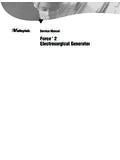Transcription of Laboratory Ventilation ACH Rates Standards and …
1 Laboratory Ventilation ACH Rates Standards and Guidelines White Paper SeriesJanuary 3, 2012 Lab Ventilation ACH Rates Standards and Guidelines January 3, 2012 White Paper Series Page 1 Table of Contents Introduction .. 2 Executive Summary .. 2 Survey of Applicable Existing Standards and Guidelines .. 2 1. US NFPA (National Fire Protection Association) Standard 45 .. 2 2. US OSHA (Occupational Safety and Health Administration) Regulations .. 3 3. ANSI/AIHA Laboratory Ventilation Standard .. 3 4. ACGIH Industrial Ventilation Manual .. 5 5. ASHRAE Standard on Ventilation for Acceptable Indoor Air Quality .. 5 6. International Mechanical Code (IMC 2009) .. 7 7. ASHRAE HVAC Applications Handbook, Chapter 14/16: Laboratories .. 8 8. European Ventilation Code Information.
2 12 Laboratory Spill Test Performance and Conclusions .. 13 1. Yale Article Published in the Journal of Chemical Health and Safety .. 13 2. Demand Based Control Study Article Published in the ASHRAE Journal .. 14 Lab Ventilation ACH Rates Standards and Guidelines January 3, 2012 White Paper Series Page 2 Introduction This document provides an overview of current US and European design practices, Standards , and regulations regarding Laboratory air change rate minimums for dilution Ventilation . Executive Summary In the US and Europe there are no prescriptive requirements for air change Rates in labs other than the ASHRAE fresh air requirements for university/college laboratories that corresponds to about ACH (.18 cfm/sq. ft or ). In terms of recommended levels, Standards are also significantly moving away from the prescribed values of the past to a more performance based approach based on the specific requirements of a given lab space.
3 Survey of Applicable Existing Standards and Guidelines The following codes and Standards have existing or past sections relating to Laboratory air change Rates . 1. US NFPA (National Fire Protection Association) Standard 45 The NFPA 45 standard is the US Standard on Fire Protection for Laboratories Using Chemicals. The previous version of this standard, NFPA 45-2004, had no actual requirements on Lab ACHs, although in the non-binding appendix of the standard there were some recommendations relating to lab ACHs that in the past had been sometimes used as a design practice. The text of these recommendations was as follows: : A minimum Ventilation rate for unoccupied laboratories ( , nights and weekends) is four room air changes per hour. Occupied laboratories typically operate at Rates of greater than eight room air changes per hour, consistent with the conditions of use for the Laboratory .
4 It is not the intent of the standard to require emergency or standby power for Laboratory Ventilation systems. However, this text and any mention of specifying lab ACHs was eliminated in the current NFPA 45 2011 standard that just recently issued: : It is not the intent of this standard to require emergency or standby power for Laboratory Ventilation systems. The only remaining reference to lab Ventilation is as follows which did not change between the 2004 and 2011 versions and does not provide any prescriptive Rates : * Laboratory units and Laboratory hoods in which chemicals are present shall be continuously ventilated under normal operating conditions. As such with the 2011 version, NFPA is now silent on prescribing any lab air change Rates other than to require continuous Ventilation .
5 Lab Ventilation ACH Rates Standards and Guidelines January 3, 2012 White Paper Series Page 3 2. US OSHA (Occupational Safety and Health Administration) Regulations OSHA in the US provides little guidance on air change Rates for labs. The only reference OSHA has to Laboratory air change Rates is quite old and is from a document published on January 31, 1990 titled Occupational Exposures to Hazardous Chemicals in Laboratories; Final Rule and was published in the Federal Register as 29 CFR Part 1910. This document does not provide any prescriptive Rates for minimum air change Rates and mainly required the creation of a Chemical Hygiene Plan by employers to document procedures, policies, and work practices to ensure workers would be protected from hazardous substances. The definition of what specifically should be in the plan was left to the employers.
6 A representative example of a Chemical Hygiene Plan that could be used as guidance for an employer to create their own Plan was provided in this document but was specifically marked as being non-mandatory. This non-mandatory plan was extracted from a 1981 book entitled Prudent Practices for Handling Hazardous Chemicals in Laboratories . Under Section C. The Laboratory Facility the following sections 4(a) and 4(f) are the only sections potentially relevant to lab air change Rates : 4. Ventilation (a) General Laboratory Ventilation . This system should: Provide a source of air for breathing and for input to local Ventilation devices (199); it should not be relied on for protection from toxic substances released into the Laboratory (198); ensure that Laboratory air is continually replaced, preventing increase of air concentrations of toxic substances during the working day (194); direct air flow into the Laboratory from non- Laboratory areas and out to the exterior of the building (194).
7 (f) Performance. Rate: 4-12 room air changes/hour is normally adequate general Ventilation if local exhaust systems such as hoods are used as the primary method of control [194]. The only reference to air change Rates as noted above are not mandatory nor are they even recommendations but rather indications of what is normally adequate general Ventilation if hoods are used. Additionally, the range is quite broad being 4 to 12 ACH and as written does not really preclude the use of lower Rates . 3. ANSI/AIHA Laboratory Ventilation Standard The 2003 version of this standard is the latest published version of this standard. With respect to Laboratory air change Rates and Ventilation the standard does not take a prescriptive approach. The format of this standard is that it has both a requirements section as expressed by the use of shall , and a recommended section that provides description and explanation of the requirements plus suggested good practices as expressed by the use of should.
8 The text of the relevant sections is as follows: Section - Volume Flow Rates /Room Ventilation Rate (2003): Requirements: The specific room Ventilation rate shall be established or agreed upon by the owner or his/her designee. Lab Ventilation ACH Rates Standards and Guidelines January 3, 2012 White Paper Series Page 4 Recommendations: Since a Ventilation system designer cannot know all possible Laboratory operations, chemicals to be utilized, and their potential for release of fumes and other toxic agents, one air exchange rate (air changes per hour) cannot be specified that will meet all conditions. Furthermore, air changes per hour is not the appropriate concept for designing contaminant control systems. Contaminants should be controlled at the source. Section - Dilution Ventilation (2003) Requirements: Dilution Ventilation shall be provided to control the buildup of fugitive emissions and odors in the Laboratory .
9 Recommendations: Control of hazardous chemicals by dilution alone, in the absence of adequate Laboratory chemical hoods, seldom is effective in protecting Laboratory users. Because the exhaust from that type of system must be discharged to the outside or treated intensively before being used as return air, these systems usually are not economical for controlling exposure to hazardous materials compared with use of local exhaust hoods. The latest version and content of the ANSI/AIHA standard has been completed, voted on and was approved. It is now in the process of being properly formatted to ANSI requirements and should be published in the first quarter of new language of what should be named the standard is similar to the 2003 standard but provides some additional clarification language beyond what the 2003 standard stated as noted below: Section - Laboratory (Room) Ventilation Rate (2012) Requirements: The specific room Ventilation rate shall be established or agreed upon by the owner or his or her designee.
10 Recommendations: Ventilation is a tool for controlling exposure. Contaminants should be controlled at the source. Potential sources should be identified and exposure control devices should be specified as appropriate to control emissions at the source. (See sections 3 and 4) All sources and assumptions should be clearly defined and documented. An air exchange rate (air changes per hour) cannot be specified that will meet all conditions. Furthermore, air changes per hour is not the appropriate concept for designing contaminant control systems. Excessive airflow with no demonstrable safety benefit other than meeting an arbitrary air change rate can waste considerable energy. Lab Ventilation ACH Rates Standards and Guidelines January 3, 2012 White Paper Series Page 5 Section - Dilution Ventilation Requirements: Dilution Ventilation shall be provided to control the buildup of fugitive emissions and odors in the Laboratory .







